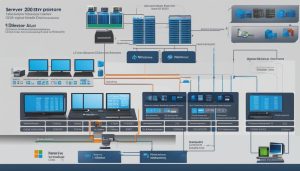Welcome to my comprehensive guide on Windows ME, also known as Windows Millennium Edition. In this article, I will delve into the features, advantages, and disadvantages of this operating system released by Microsoft in September 2000.
Windows ME was designed as an upgrade to Windows 98 Second Edition, with the aim of providing a better user experience and improved multimedia capabilities. It introduced features such as Windows Media Player 7 and Windows Movie Maker, transforming it into a multimedia entertainment center.
However, Windows ME had its drawbacks. It was notorious for its instability and compatibility issues, which led many users to stick with Windows 98 or upgrade to Windows 2000. Despite these challenges, Windows ME introduced several new features that aimed to enhance the user experience, such as a redesigned Windows desktop, customizable background settings, and improved Windows Help and search functionality.
Key Takeaways:
- Windows ME, also known as Windows Millennium Edition, was an operating system released by Microsoft in September 2000.
- It aimed to provide a better user experience and improved multimedia capabilities.
- Windows ME introduced features such as Windows Media Player 7 and Windows Movie Maker.
- However, it was plagued by instability and compatibility issues, leading many users to stick with Windows 98 or upgrade to Windows 2000.
- Windows XP eventually replaced Windows ME in October 2001, offering a more stable and feature-rich operating system.
Features of Windows ME
Windows ME introduced several new features that aimed to enhance the user experience. Some of these features included:
- A redesigned Windows desktop, providing a fresh and modern look.
- Customizable background settings, allowing users to personalize their desktop.
- Improved Windows Help and search functionality, making it easier to find the information users needed.
- The ability to create and organize folders, facilitating better file management.
- The option to create shortcuts for easy access to files and programs, increasing productivity.
- Preinstalled Windows accessories, such as Paint, Calculator, and Notepad, providing essential tools at users’ fingertips.
These features were intended to make Windows ME a more user-friendly and convenient operating system. However, despite these advancements, Windows ME faced significant challenges that affected its overall performance and popularity.
“Windows ME’s redesigned desktop and customizable settings were a step in the right direction. It allowed users to personalize their computing experience and make it their own. However, the instability and compatibility issues overshadowed these improvements, making it difficult to fully embrace the new features.”
In addition to its features, Windows ME came with its fair share of advantages and disadvantages:
| Advantages | Disadvantages |
|---|---|
| Improved multimedia capabilities | Frequent crashes and stability issues |
| New system restore and file protection features | Compatibility issues with hardware and software |
| Enhanced user interface | Lack of enterprise-level features |
These advantages and disadvantages shaped the overall perception of Windows ME and influenced users’ decisions when choosing an operating system.
Windows ME vs Windows 2000: A Comparison of Operating Systems
Windows ME and Windows 2000 are two operating systems released by Microsoft with distinct target audiences and features. While Windows ME was designed for home users, Windows 2000 was tailored to meet the needs of businesses. Let’s explore the key differences between these two operating systems and their impact on the computing landscape.
Windows ME History
Windows ME, also known as Windows Millennium Edition, was released in September 2000. It aimed to improve the user experience and multimedia capabilities compared to its predecessor, Windows 98 Second Edition. Windows ME introduced features like Windows Media Player 7 and Windows Movie Maker, transforming it into a multimedia entertainment center. However, Windows ME struggled with stability and compatibility issues, leading many users to stick with Windows 98 or upgrade to the more reliable Windows 2000.
Windows 2000: Stability and Advanced Features
Windows 2000, based on the Windows NT architecture, was released in February 2000, targeting business users. It offered enhanced stability, security, networking capabilities, and multi-user support. Windows 2000 included advanced features like Active Directory, which revolutionized network management for organizations. In contrast to Windows ME, Windows 2000 lacked the consumer-focused multimedia features but provided a more reliable and robust operating system for business users.
While Windows ME still relied on the older DOS architecture, Windows 2000 built upon the more advanced Windows NT architecture, making it a preferred choice for businesses that required stability, security, and compatibility with older software.
A Choice between Home and Business
The choice between Windows ME and Windows 2000 ultimately boiled down to the targeted user base and their specific needs. Home users looking for a multimedia-centric operating system may have been attracted to Windows ME’s features. However, businesses seeking stability, security, and compatibility with enterprise-grade software and networks would have found Windows 2000 more suitable.
In conclusion, while Windows ME and Windows 2000 were released around the same time, they catered to different audiences and had distinct features. Windows ME targeted home users with multimedia features, while Windows 2000 focused on the needs of businesses with its stability and advanced networking capabilities. The release of Windows XP eventually replaced both operating systems, offering a unified platform that combined the best aspects of both Windows ME and Windows 2000.
Windows ME’s Shortcomings
Windows ME received significant criticism for its instability and compatibility issues, which became some of its most notable shortcomings. Users frequently encountered crashes and the notorious “blue screen of death” error, leading to frustration and dissatisfaction. The lack of reliable performance hindered users from fully utilizing the operating system’s features and capabilities.
One of the main points of concern was hardware and software compatibility. Many users reported problems with hardware drivers and software applications not functioning properly or crashing frequently. This issue made it difficult for users to rely on Windows ME for their daily tasks and activities, as they were constantly faced with the risk of system failures and data loss.
“Windows ME was a nightmare for me as a user. I experienced frequent crashes and compatibility issues with my hardware and software. It was incredibly frustrating, and I ended up reverting back to Windows 98.” – John, Windows ME user
Additionally, Windows ME removed support for real-mode DOS, which was still necessary for running some older DOS-based software. This decision left users with limited options for utilizing their existing software applications, forcing them to either find alternatives or stick with outdated Windows 98.
| Shortcomings of Windows ME | Consequences |
|---|---|
| Instability and frequent crashes | Loss of productivity, frustration for users |
| Compatibility issues with hardware and software | Unreliable performance, frequent system failures |
| Removal of real-mode DOS support | Limited compatibility with older software |
Overall, these shortcomings contributed significantly to the negative reputation of Windows ME, and many users opted to either stick with the more stable Windows 98 or upgrade to alternatives like Windows 2000. The limitations and frustrations experienced with Windows ME paved the way for the release of Windows XP, which aimed to address these issues and provide a more reliable and user-friendly operating system.
The Impact of Windows XP
Windows XP, released in 2001, revolutionized the world of operating systems. It was a significant improvement over its predecessor, Windows ME, and quickly became a fan favorite among both home and business users. Windows XP combined the stability and robustness of the Windows NT architecture with a user-friendly interface and enhanced multimedia features. It was a game-changer for Microsoft and set a new standard in operating system design.
One of the major advantages of Windows XP was its improved stability. It addressed many of the issues that plagued Windows ME, such as frequent crashes and the dreaded “blue screen of death.” Windows XP was much more reliable and provided a seamless user experience, making it a preferred choice for users who valued a stable operating system.
Additionally, Windows XP introduced a wide range of features and functionalities that enhanced productivity and user convenience. It offered improved networking capabilities, making it easier for users to connect to the internet and share files. Windows XP also included built-in support for wireless networking, which was a significant advancement at the time. Furthermore, it introduced a new user interface, featuring the iconic Start menu, taskbar, and visually appealing desktop themes.
Windows XP quickly gained popularity among home users and businesses alike. Its compatibility with older software and hardware made the transition from older operating systems seamless and hassle-free. Many software developers also embraced Windows XP, ensuring that their programs were fully optimized for the new operating system. This widespread support contributed to the success of Windows XP and solidified its position as one of the most beloved operating systems of all time.
In summary, Windows XP made a lasting impact on the world of operating systems. Its stability, user-friendly interface, and enhanced features set a new standard for Microsoft and quickly won over users. Windows XP’s success paved the way for future iterations of the Windows operating system and solidified Microsoft’s dominance in the market. It remains a fondly remembered and widely respected operating system to this day.
| Advantages of Windows XP | Disadvantages of Windows XP |
|---|---|
|
|
Conclusion
In conclusion, Windows ME was an operating system released by Microsoft in 2000. While it sought to enhance the user experience and multimedia capabilities, it faced numerous challenges. Windows ME’s instability and compatibility issues deterred many users from adopting it, leading them to stick with Windows 98 or opt for more stable alternatives like Windows 2000.
Despite introducing new features such as Windows Media Player 7 and System Restore, Windows ME’s drawbacks overshadowed its advancements. The operating system’s reputation suffered due to frequent crashes, hardware support problems, and software compatibility issues. Furthermore, the removal of real-mode DOS support limited its compatibility with older software.
In the end, Windows XP emerged as the successor to Windows ME, providing a reliable and feature-rich operating system that catered to the needs of both home and business users. With the release of Windows XP, Microsoft unified its desktop version of Windows, leaving behind the shortcomings of Windows ME.
FAQ
What is Windows ME?
Windows ME, also known as Windows Millennium Edition, was an operating system released by Microsoft in September 2000.
What were the features of Windows ME?
Windows ME introduced features such as Windows Media Player 7, Windows Movie Maker, System Restore, and System File Protection.
How did Windows ME compare to Windows 2000?
Windows ME was designed for home users, while Windows 2000 targeted business users and offered more stability and advanced features.
What were the shortcomings of Windows ME?
Windows ME faced criticism for its instability, compatibility issues, and lack of enterprise-level features.
What impact did Windows XP have?
Windows XP provided a more stable and reliable operating system that addressed the shortcomings of Windows ME.
Janina is a senior specialist in information technology


